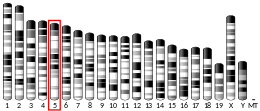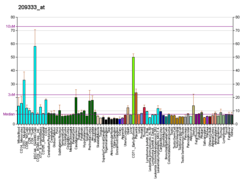ULK1
ULK1 is an enzyme that in humans is encoded by the ULK1 gene.[5][6]
Unc-51 like autophagy activating kinase (ULK1/2) are two similar isoforms of an enzyme that in humans are encoded by the ULK1/2 genes.[5][6] It is specifically a kinase that is involved with autophagy, particularly in response to amino acid withdrawal. Not many studies have been done comparing the two isoforms, but some differences have been recorded.[7]
Function
Ulk1/2 is an important protein in autophagy for mammalian cells, and is homologous to ATG1 in yeast. It is part of the ULK1-complex, which is needed in early steps of autophagosome biogenesis. The ULK1 complex also consists of the FAK family kinase interacting protein of 200 kDa (FIP200 or RB1CC1) and the HORMA (Hop/Rev7/Mad2) domain-containing proteins ATG13 and ATG101.[8] ULK1, specifically, appears to be the most essential for autophagy and is activated under conditions of nutrient deprivation by several upstream signals which is followed by the initiation of autophagy.[9] However, ULK1 and ULK2 show high functional redundancy; studies have shown that ULK2 can compensate for the loss of ULK1. Nutrient dependent autophagy is only fully inhibited if both ULK1 and ULK2 are knocked out.
ULK1 has many downstream phosphorylation targets to aid in this induction of the isolation membrane/ autophagosome. Recently, a mechanism for autophagy has been elucidated. Models have proposed that the active ULK1 directly phosphorylates Beclin-1 at Ser 14 and activates the pro-autophagy class III phosphoinositide 3-kinase (PI(3)K), VPS34 complex, to promote autophagy induction and maturation.[10]
Ulk1/2 is negatively regulated by mTORC1 activity, which is active during anabolic-type environmental cues. In contrast, Ulk1/2 is activated by AMPK activity from starvation signals.[11]
Ulk1/2 may have critical roles beyond what ATG1 performs in yeast, including neural growth and development.
Interactions
When active, mTORC1 inhibits autophagy by phosphorylating both ULK1 and ATG13, which reduces the kinase activity of ULK1. Under starvation conditions, mTORC1 is inhibited and dissociates from ULK1 allowing it to become active. AMPK is activated when intracellular AMP increases which occurs under starvation conditions, which inactivates mTORC1, and thus directly activates ULK1. AMPK also directly phosphorylates ULK1 at multiple sites in the linker region between the kinase and C-terminal domains.[8]
ULK1 can phosphorylate itself as well as ATG13 and RB1CC1, which are regulatory proteins; however, the direct substrate of ULK1 has not been identified although recent studies suggest it phosphorylates Beclin-1.
Upon proteotoxic stresses, ULK1 has been found to phosphorylate the adaptor protein p62, which increases the binding affinity of p62 for ubiquitin.[8][12]
ULK1 has been shown to interact with Raptor, Beclin1, Class-III-PI3K, GABARAPL2,[7] GABARAP,[7][8] SYNGAP1[9] and SDCBP.[9]
Structure
ULK1 is a 112-kDa protein. It contains a N-terminal kinase domain, a serine-proline rich region, and a C-terminal interacting domain. The serine-proline rich region has been shown experimentally to be the site of phosphorylation by mTORC1 and AMPK—a negative and positive regulator of ULK1 activity, respectively. The C-terminal domain contains two microtubule-interacting and transport (MIT) domains and acts as a scaffold which links ULK1, ATG13, and FIFP200 together to form a complex that is essential to initiate autophagy. Early autophagy targeting/tethering (EAT) domains in the C-terminus are arranged as MIT domains consisting of two three-helix bundles. MIT domains also mediate interactions with membranes. The N-terminus contains a serine-threonine kinase domain. ULK1 also contains a large activation loop between the N and C terminus that is positively charged. This region may regulate kinase activity and play a role in recognizing different substrates. ULK1 and ULK2 share significant homology in both the C-terminal and N-terminal domains.[9]
Related Diseases
Given ULK1's role in autophagy, many diseases such as cancer,[13] neurodegenerative disorders, neurodevelopment disorders,[14] and Crohn's disease[15] could be attributed to any impairments in autophagy regulation.
In cancer specifically, ULK1 has become an attractive therapeutic target. Since autophagy acts as a cell survival trait for cells, it enables tumors (once they are already formed) to survive energy deprivation and other stresses such as chemotherapeutics. For that reason, inhibiting autophagy may prove to be beneficial. Thus, inhibitors have been targeted towards ULK1.[16]
References
- GRCh38: Ensembl release 89: ENSG00000177169 - Ensembl, May 2017
- GRCm38: Ensembl release 89: ENSMUSG00000029512 - Ensembl, May 2017
- "Human PubMed Reference:". National Center for Biotechnology Information, U.S. National Library of Medicine.
- "Mouse PubMed Reference:". National Center for Biotechnology Information, U.S. National Library of Medicine.
- Kuroyanagi H, Yan J, Seki N, Yamanouchi Y, Suzuki Y, Takano T, Muramatsu M, Shirasawa T (Jul 1998). "Human ULK1, a novel serine/threonine kinase related to UNC-51 kinase of Caenorhabditis elegans: cDNA cloning, expression, and chromosomal assignment". Genomics. 51 (1): 76–85. doi:10.1006/geno.1998.5340. PMID 9693035.
- "Entrez Gene: ULK1 unc-51-like kinase 1 (C. elegans)".
- Ro, Seung-Hyun; Jung, Chang Hwa; Hahn, Wendy S.; Xu, Xin; Kim, Young-Mi; Yun, Young Sung; Park, Ji-Man; Kim, Kwan Hyun; Seo, Minchul (December 2013). "Distinct functions of Ulk1 and Ulk2 in the regulation of lipid metabolism in adipocytes". Autophagy. 9 (12): 2103–2114. doi:10.4161/auto.26563. ISSN 1554-8635. PMC 4028344. PMID 24135897.
- Lin MG, Hurley JH (2016). "Structure and function of the ULK1 complex in autophagy". Current Opinion in Cell Biology. 39: 61–8. doi:10.1016/j.ceb.2016.02.010. PMC 4828305. PMID 26921696.
- Lazarus MB, Novotny CJ, Shokat KM (2015). "Structure of the human autophagy initiating kinase ULK1 in complex with potent inhibitors". ACS Chemical Biology. 10 (1): 257–61. doi:10.1021/cb500835z. PMC 4301081. PMID 25551253.
- Russell RC, Tian Y, Yuan H, Park HW, Chang YY, Kim J, Kim H, Neufeld TP, Dillin A, Guan KL (2013). "ULK1 induces autophagy by phosphorylating Beclin-1 and activating VPS34 lipid kinase". Nature Cell Biology. 15 (7): 741–50. doi:10.1038/ncb2757. PMC 3885611. PMID 23685627.
- Kim J, Kundu M, Viollet B, Guan KL (2011). "AMPK and mTOR regulate autophagy through direct phosphorylation of Ulk1". Nature Cell Biology. 13 (2): 132–41. doi:10.1038/ncb2152. PMC 3987946. PMID 21258367.
- Lim J, Lachenmayer ML, Wu S, Liu W, Kundu M, Wang R, Komatsu M, Oh YJ, Zhao Y, Yue Z (2015). "Proteotoxic stress induces phosphorylation of p62/SQSTM1 by ULK1 to regulate selective autophagic clearance of protein aggregates". PLoS Genetics. 11 (2): e1004987. doi:10.1371/journal.pgen.1004987. PMC 4344198. PMID 25723488.
- Chen MB, Ji XZ, Liu YY, Zeng P, Xu XY, Ma R, Guo ZD, Lu JW, Feng JF (2017). "Ulk1 over-expression in human gastric cancer is correlated with patients' T classification and cancer relapse". Oncotarget. 8 (20): 33704–33712. doi:10.18632/oncotarget.16734. PMC 5464904. PMID 28410240.
- Lee KM, Hwang SK, Lee JA (2013). "Neuronal autophagy and neurodevelopmental disorders". Experimental Neurobiology. 22 (3): 133–42. doi:10.5607/en.2013.22.3.133. PMC 3807000. PMID 24167408.
- Henckaerts L, Cleynen I, Brinar M, John JM, Van Steen K, Rutgeerts P, Vermeire S (2011). "Genetic variation in the autophagy gene ULK1 and risk of Crohn's disease". Inflammatory Bowel Diseases. 17 (6): 1392–7. doi:10.1002/ibd.21486. PMID 21560199.
- Egan DF, Chun MG, Vamos M, Zou H, Rong J, Miller CJ, Lou HJ, Raveendra-Panickar D, Yang CC, Sheffler DJ, Teriete P, Asara JM, Turk BE, Cosford ND, Shaw RJ (2015). "Small Molecule Inhibition of the Autophagy Kinase ULK1 and Identification of ULK1 Substrates". Molecular Cell. 59 (2): 285–97. doi:10.1016/j.molcel.2015.05.031. PMC 4530630. PMID 26118643.
Further reading
- Russell RC, Tian Y, Yuan H, Park HW, Chang YY, Kim J, Kim H, Neufeld TP, Dillin A, Guan KL (2013). "ULK1 induces autophagy by phosphorylating Beclin-1 and activating VPS34 lipid kinase". Nature Cell Biology. 15 (7): 741–50. doi:10.1038/ncb2757. PMC 3885611. PMID 23685627.
- Nagase T, Ishikawa K, Suyama M, Kikuno R, Miyajima N, Tanaka A, Kotani H, Nomura N, Ohara O (Oct 1998). "Prediction of the coding sequences of unidentified human genes. XI. The complete sequences of 100 new cDNA clones from brain which code for large proteins in vitro". DNA Research. 5 (5): 277–86. doi:10.1093/dnares/5.5.277. PMID 9872452.
- Hartley JL, Temple GF, Brasch MA (Nov 2000). "DNA cloning using in vitro site-specific recombination". Genome Research. 10 (11): 1788–95. doi:10.1101/gr.143000. PMC 310948. PMID 11076863.
- Okazaki N, Yan J, Yuasa S, Ueno T, Kominami E, Masuho Y, Koga H, Muramatsu M (Dec 2000). "Interaction of the Unc-51-like kinase and microtubule-associated protein light chain 3 related proteins in the brain: possible role of vesicular transport in axonal elongation". Brain Research. Molecular Brain Research. 85 (1–2): 1–12. doi:10.1016/S0169-328X(00)00218-7. PMID 11146101.
- Tomoda T, Kim JH, Zhan C, Hatten ME (Mar 2004). "Role of Unc51.1 and its binding partners in CNS axon outgrowth". Genes & Development. 18 (5): 541–58. doi:10.1101/gad.1151204. PMC 374236. PMID 15014045.
- Young AR, Chan EY, Hu XW, Köchl R, Crawshaw SG, High S, Hailey DW, Lippincott-Schwartz J, Tooze SA (Sep 2006). "Starvation and ULK1-dependent cycling of mammalian Atg9 between the TGN and endosomes". Journal of Cell Science. 119 (Pt 18): 3888–900. doi:10.1242/jcs.03172. PMID 16940348.
- Olsen JV, Blagoev B, Gnad F, Macek B, Kumar C, Mortensen P, Mann M (Nov 2006). "Global, in vivo, and site-specific phosphorylation dynamics in signaling networks". Cell. 127 (3): 635–48. doi:10.1016/j.cell.2006.09.026. PMID 17081983.
- Wissing J, Jänsch L, Nimtz M, Dieterich G, Hornberger R, Kéri G, Wehland J, Daub H (Mar 2007). "Proteomics analysis of protein kinases by target class-selective prefractionation and tandem mass spectrometry". Molecular & Cellular Proteomics. 6 (3): 537–47. doi:10.1074/mcp.T600062-MCP200. PMID 17192257.
- Ewing RM, Chu P, Elisma F, Li H, Taylor P, Climie S, McBroom-Cerajewski L, Robinson MD, O'Connor L, Li M, Taylor R, Dharsee M, Ho Y, Heilbut A, Moore L, Zhang S, Ornatsky O, Bukhman YV, Ethier M, Sheng Y, Vasilescu J, Abu-Farha M, Lambert JP, Duewel HS, Stewart II, Kuehl B, Hogue K, Colwill K, Gladwish K, Muskat B, Kinach R, Adams SL, Moran MF, Morin GB, Topaloglou T, Figeys D (2007). "Large-scale mapping of human protein-protein interactions by mass spectrometry". Molecular Systems Biology. 3 (1): 89. doi:10.1038/msb4100134. PMC 1847948. PMID 17353931.
- Chan EY, Kir S, Tooze SA (Aug 2007). "siRNA screening of the kinome identifies ULK1 as a multidomain modulator of autophagy". The Journal of Biological Chemistry. 282 (35): 25464–74. doi:10.1074/jbc.M703663200. PMID 17595159.




